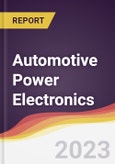A more than 150-page report is developed to help in your business decisions. To learn the scope of benefits, companies researched and other details of the power electronics market, then read this report.
The study includes the power electronics market size and forecast for the power electronics market through 2024, segmented by application, by component, by end use, by electric vehicle type, and by region as follows:
By Application [$M shipment analysis for 2013-2024]:
- Powertrain and chassis
- Body electronics
- Safety & security systems
- Infotainment & telematics
By Component [$M shipment analysis for 2013-2024]:
- Microcontroller units (MCUs)
- Power ICs
- Sensors
- Others
By End Use [$M shipment analysis for 2013-2024]:
- Passenger cars
- Small cars
- Compact cars
- Mid-Sized cars
- Luxury cars
- SUVs & Crossovers
- Light Commercial vehicles
By Electric Vehicle Type [$M shipment analysis for 2013-2024]:
- Battery Electric Vehicle
- Hybrid Electric Vehicle
- Plug-in-Hybrid Electric Vehicle
By Region [$M shipment analysis for 2013-2024}:
- North America
- United States
- Canada
- Mexico
- Europe
- Germany
- UK
- Italy
- Asia Pacific
- China
- Japan
- India
- Rest of the World
- Brazil
- Turkey
Some of the automotive power electronics companies profiled in this report include Analog Devices, Continental, Dialog Semiconductor, Diodes Incorporated, Fuji Electric, Infineon Technologies, Kongsberg Automotive, Maxim Integrated, Microchip Technology, Microsemi Corporation, Mitsubishi Electric, NXP Semiconductors, on Semiconductor, Qualcomm Technologies, Renesas Electronics, Robert Bosch, Rohm Semiconductor, Stmicroelectronics, Taiwan Semiconductor, Texas Instruments, and Toshiba Corporation.
Some of the features of 'Automotive Power Electronics Market 2019-2024: Trends, Forecast, and Opportunity Analysis' include
- Market size estimates: Automotivepower electronics market size estimation in terms of value ($M) shipment.
- Trend and forecast analysis: Market trend (2013-2018) and forecast (2019-2024) by application, and end use industry.
- Segmentation analysis: Market size by application, by component, by end use, by electric vehicle type, and by region.
- Regional analysis: Automotivepower electronics market breakdown by North America, Europe, Asia Pacific, and the Rest of the World.
- Growth opportunities: Analysis on growth opportunities in different applications and regions for power electronics in the automotive power electronics market.
- Strategic analysis: This includes M&A, new product development, and competitive landscape for, power electronics in the automotivepower electronics market.
- Analysis of competitive intensity of the industry based on Porter’s Five Forces model.
This report answers the following 11 key questions:
Q.1 What are some of the most promising potential, high-growth opportunities for the automotive power electronics market by application type (powertrain and chassis, body electronics, safety & security systems, Infotainment & Telematics), by component type (microcontroller Units, power ICs, sensors, and others), by end use (passenger cars, and light commercial vehicles), by electric vehicle type (BEV, HEV, and PHEV), and by region (North America, Europe, Asia Pacific, and ROW)?
Q.2 Which segments will grow at a faster pace and why?
Q.3 Which regions will grow at a faster pace and why?
Q.4 What are the key factors affecting market dynamics? What are the drivers and challenges of the automotive power electronics market?
Q.5 What are the business risks and threats to the power electronics market?
Q.6 What are emerging trends in this automotive power electronics market and the reasons behind them?
Q.7 What are some changing demands of customers in the automotive power electronics market?
Q.8 What are the new developments in the automotive power electronics market? Which companies are leading these developments?
Q.9 Who are the major players in this automotive power electronics market? What strategic initiatives are being implemented by key players for business growth?
Q.10 What are some of the competitive products and processes in this automotive power electronics area and how big of a threat do they pose for loss of market share via material or product substitution?
Q.11 What M & A activities have taken place in the last 5 years in this, automotive power electronics market?
This product will be delivered within 1-3 business days.
Table of Contents
Companies Mentioned
- Analog Devices
- Continental AG
- Dialog Semiconductor
- Diodes Incorporated
- Fuji Electric
- Infineon Technologies
- Kongsberg Automotive
- Maxim Integrated
- Microchip Technology
- Microsemi Corporation
Methodology
The analyst has been in the business of market research and management consulting since 2000 and has published over 600 market intelligence reports in various markets/applications and served over 1,000 clients worldwide. Each study is a culmination of four months of full-time effort performed by the analyst team. The analysts used the following sources for the creation and completion of this valuable report:
- In-depth interviews of the major players in the market
- Detailed secondary research from competitors’ financial statements and published data
- Extensive searches of published works, market, and database information pertaining to industry news, company press releases, and customer intentions
- A compilation of the experiences, judgments, and insights of professionals, who have analyzed and tracked the market over the years.
Extensive research and interviews are conducted in the supply chain of the market to estimate market share, market size, trends, drivers, challenges and forecasts.
Thus, the analyst compiles vast amounts of data from numerous sources, validates the integrity of that data, and performs a comprehensive analysis. The analyst then organizes the data, its findings, and insights into a concise report designed to support the strategic decision-making process.

LOADING...








